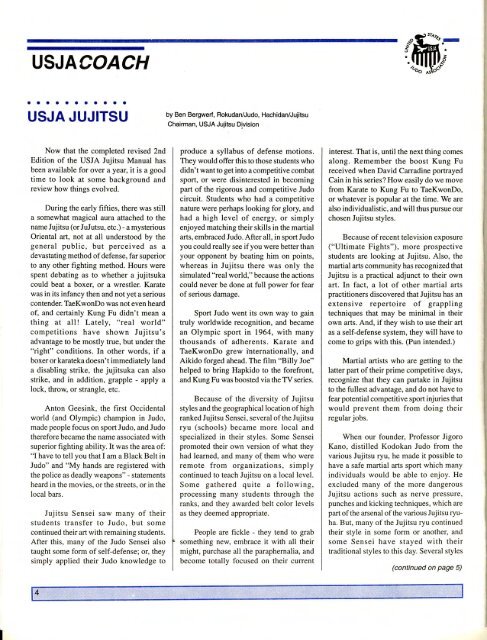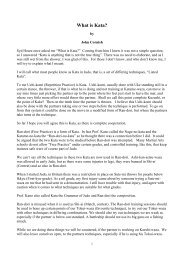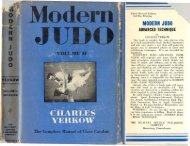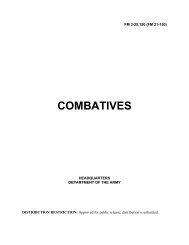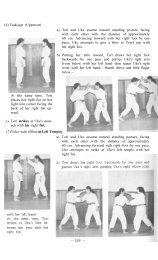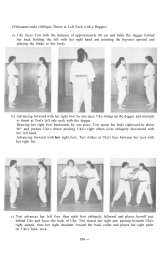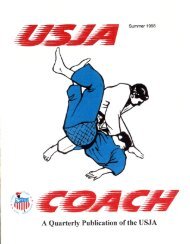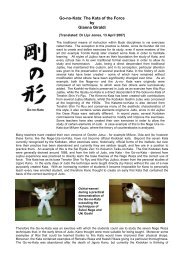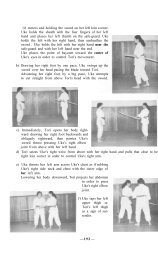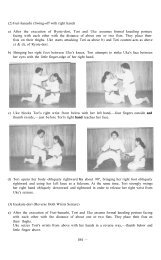Fall 1998 - Judo Information Site
Fall 1998 - Judo Information Site
Fall 1998 - Judo Information Site
You also want an ePaper? Increase the reach of your titles
YUMPU automatically turns print PDFs into web optimized ePapers that Google loves.
USJACOACH<br />
':fu;<br />
a a a a a a a a a a a<br />
USJA JUJITSU<br />
by Ben Bergwerf, Rokudan/<strong>Judo</strong>, Hachidan/Jujitsu<br />
Chairman, USJA Jujitsu Division<br />
Now that the completed revised 2nd<br />
Edition of the USJA Jujitsu Manual has<br />
been available for over ayear, it is a good<br />
time to look at some background and<br />
review how things evolved.<br />
During the early fifties, there was still<br />
a somewhat magical aura attached to the<br />
name Jujitsu (or JuJutsu, etc.) - a mysterious<br />
Oriental art, not at all understood by the<br />
general public, but perceived as a<br />
devastating method ofdefense, far superior<br />
to any other fighting method. Hours were<br />
spent debating as to whether a jujitsuka<br />
could beat a boxer. or a wrestler. Karate<br />
was in its infancy then and not yet a serious<br />
contender. TaeKwonDo was not even heard<br />
of, and certainly Kung Fu didn't mean a<br />
thing at all ! Lately,<br />
"real<br />
world"<br />
competitions have shown Jujitsu's<br />
advantage to be mostly true, but under the<br />
"right" conditions. In other words, if a<br />
boxer or karateka doesn't immediately land<br />
a disabling strike, the jujitsuka can also<br />
strike, and in addition, grapple - apply a<br />
lock, throw, or strangle, etc.<br />
Anton Geesink, the first Occidental<br />
world (and Olympic) champion in <strong>Judo</strong>,<br />
made people focus on sport <strong>Judo</strong>, and <strong>Judo</strong><br />
therefore became the name associated with<br />
superior fighting ability. It was the area of:<br />
"I have to tell you that I am a Black Belt in<br />
<strong>Judo</strong>" and "My hands are registered with<br />
the police as deadly weapons" - statements<br />
heard in the movies, or the streets, or in the<br />
local bars.<br />
Jujitsu Sensei saw many of their<br />
students transfer to <strong>Judo</strong>, but some<br />
continued their art with remaining students.<br />
After this, many of the <strong>Judo</strong> Sensei also<br />
taught some form of self-defense; or, they<br />
simply applied their <strong>Judo</strong> knowledge to<br />
produce a syllabus of defense motions.<br />
They would offer this to those students who<br />
didn't want to get into acompetitive combat<br />
sport, or were disinterested in becoming<br />
part of the rigorous and competitive <strong>Judo</strong><br />
circuit. Students who had a competitive<br />
nature were perhaps looking for glory and<br />
had a high level of energy, or simply<br />
enjoyed matching their skills in the martial<br />
arts, embraced <strong>Judo</strong>. After all, in sport <strong>Judo</strong><br />
you could really see ifyou were better than<br />
your opponent by beating him on points,<br />
whereas in Jujitsu there was only the<br />
simulated "real world." because the actions<br />
could never be done at full power for fear<br />
of serious damage.<br />
Sport <strong>Judo</strong> went its own way to gain<br />
truly worldwide recognition, and became<br />
an Olympic sport in 1964, with many<br />
thousands of adherents. Karate and<br />
TaeKwonDo grew i'nternationally, and<br />
Aikido forged ahead. The film "Billy Joe"<br />
helped to bring Hapkido to the forefront,<br />
and Kung Fu was boosted via theTV series.<br />
Because of the diversity of Jujitsu<br />
styles and the geographicalocation ofhigh<br />
ranked Jujitsu Sensei, several of the Jujitsu<br />
ryu (schools) became more local and<br />
specialized in their styles. Some Sensei<br />
promoted their own version of what they<br />
had learned, and many of them who were<br />
remote from organizations, simply<br />
continued to teach Jujitsu on a local level.<br />
Some gathered quite a following,<br />
processing many students through the<br />
ranks, and they awarded belt color levels<br />
as they deemed appropriate.<br />
People are fickle - they tend to grab<br />
something new, embrace it with all their<br />
might, purchase all the paraphernalia, and<br />
become totally focused on their current<br />
interest. That is, until the next thing comes<br />
along. Remember the boost Kung Fu<br />
received when David Carradine portrayed<br />
Cain in his series? How easily do we move<br />
from Karate to Kung Fu to TaeKwonDo,<br />
or whatever is popular at the time. We are<br />
also individualistic, and will thus pursue our<br />
chosen Jujitsu styles.<br />
Because of recent television exposure<br />
("Ultimate Fights"), more prospective<br />
students are looking at Jujitsu. Also, the<br />
martial arts community has recognized that<br />
Jujitsu is a practical adjunct to their own<br />
art. In fact, a lot of other martial arts<br />
practitioners discovered that Jujitsu has an<br />
extensive repertoire of grappling<br />
techniques that may be minimal in their<br />
own arts. And, if they wish to use their art<br />
as a self-defense system, they will have to<br />
come to grips with this. (Pun intended.)<br />
Martial artists who are getting to the<br />
latter part of their prime competitive days,<br />
recognize that they can partake in Jujitsu<br />
to the fullest advantage, and do not have to<br />
fear potential competitive sport injuries that<br />
would prevent them from doing their<br />
regular jobs.<br />
When our founder, Professor Jigoro<br />
Kano, distilled Kodokan <strong>Judo</strong> from the<br />
various Jujitsu ryu, he made it possible to<br />
have a safe martial arts sport which many<br />
individuals would be able to enjoy. He<br />
excluded many of the more dangerous<br />
Jujitsu actions such as nerve pressure,<br />
punches and kicking techniques, which are<br />
part of the arsenal of the various Jujitsu ryuha.<br />
But, many of the Jujitsu ryu continued<br />
their style in some form or another, and<br />
some Sensei have stayed with their<br />
traditional styles to this day. Several styles<br />
(continued on page 5)


